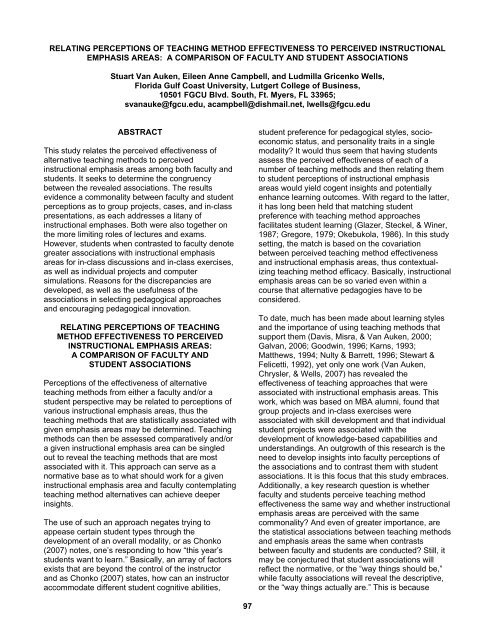2008 - Marketing Educators' Association
2008 - Marketing Educators' Association
2008 - Marketing Educators' Association
Create successful ePaper yourself
Turn your PDF publications into a flip-book with our unique Google optimized e-Paper software.
RELATING PERCEPTIONS OF TEACHING METHOD EFFECTIVENESS TO PERCEIVED INSTRUCTIONAL<br />
EMPHASIS AREAS: A COMPARISON OF FACULTY AND STUDENT ASSOCIATIONS<br />
Stuart Van Auken, Eileen Anne Campbell, and Ludmilla Gricenko Wells,<br />
Florida Gulf Coast University, Lutgert College of Business,<br />
10501 FGCU Blvd. South, Ft. Myers, FL 33965;<br />
svanauke@fgcu.edu, acampbell@dishmail.net, lwells@fgcu.edu<br />
ABSTRACT<br />
This study relates the perceived effectiveness of<br />
alternative teaching methods to perceived<br />
instructional emphasis areas among both faculty and<br />
students. It seeks to determine the congruency<br />
between the revealed associations. The results<br />
evidence a commonality between faculty and student<br />
perceptions as to group projects, cases, and in-class<br />
presentations, as each addresses a litany of<br />
instructional emphases. Both were also together on<br />
the more limiting roles of lectures and exams.<br />
However, students when contrasted to faculty denote<br />
greater associations with instructional emphasis<br />
areas for in-class discussions and in-class exercises,<br />
as well as individual projects and computer<br />
simulations. Reasons for the discrepancies are<br />
developed, as well as the usefulness of the<br />
associations in selecting pedagogical approaches<br />
and encouraging pedagogical innovation.<br />
RELATING PERCEPTIONS OF TEACHING<br />
METHOD EFFECTIVENESS TO PERCEIVED<br />
INSTRUCTIONAL EMPHASIS AREAS:<br />
A COMPARISON OF FACULTY AND<br />
STUDENT ASSOCIATIONS<br />
Perceptions of the effectiveness of alternative<br />
teaching methods from either a faculty and/or a<br />
student perspective may be related to perceptions of<br />
various instructional emphasis areas, thus the<br />
teaching methods that are statistically associated with<br />
given emphasis areas may be determined. Teaching<br />
methods can then be assessed comparatively and/or<br />
a given instructional emphasis area can be singled<br />
out to reveal the teaching methods that are most<br />
associated with it. This approach can serve as a<br />
normative base as to what should work for a given<br />
instructional emphasis area and faculty contemplating<br />
teaching method alternatives can achieve deeper<br />
insights.<br />
The use of such an approach negates trying to<br />
appease certain student types through the<br />
development of an overall modality, or as Chonko<br />
(2007) notes, one’s responding to how “this year’s<br />
students want to learn.” Basically, an array of factors<br />
exists that are beyond the control of the instructor<br />
and as Chonko (2007) states, how can an instructor<br />
accommodate different student cognitive abilities,<br />
97<br />
student preference for pedagogical styles, socioeconomic<br />
status, and personality traits in a single<br />
modality? It would thus seem that having students<br />
assess the perceived effectiveness of each of a<br />
number of teaching methods and then relating them<br />
to student perceptions of instructional emphasis<br />
areas would yield cogent insights and potentially<br />
enhance learning outcomes. With regard to the latter,<br />
it has long been held that matching student<br />
preference with teaching method approaches<br />
facilitates student learning (Glazer, Steckel, & Winer,<br />
1987; Gregore, 1979; Okebukola, 1986). In this study<br />
setting, the match is based on the covariation<br />
between perceived teaching method effectiveness<br />
and instructional emphasis areas, thus contextualizing<br />
teaching method efficacy. Basically, instructional<br />
emphasis areas can be so varied even within a<br />
course that alternative pedagogies have to be<br />
considered.<br />
To date, much has been made about learning styles<br />
and the importance of using teaching methods that<br />
support them (Davis, Misra, & Van Auken, 2000;<br />
Galvan, 2006; Goodwin, 1996; Karns, 1993;<br />
Matthews, 1994; Nulty & Barrett, 1996; Stewart &<br />
Felicetti, 1992), yet only one work (Van Auken,<br />
Chrysler, & Wells, 2007) has revealed the<br />
effectiveness of teaching approaches that were<br />
associated with instructional emphasis areas. This<br />
work, which was based on MBA alumni, found that<br />
group projects and in-class exercises were<br />
associated with skill development and that individual<br />
student projects were associated with the<br />
development of knowledge-based capabilities and<br />
understandings. An outgrowth of this research is the<br />
need to develop insights into faculty perceptions of<br />
the associations and to contrast them with student<br />
associations. It is this focus that this study embraces.<br />
Additionally, a key research question is whether<br />
faculty and students perceive teaching method<br />
effectiveness the same way and whether instructional<br />
emphasis areas are perceived with the same<br />
commonality? And even of greater importance, are<br />
the statistical associations between teaching methods<br />
and emphasis areas the same when contrasts<br />
between faculty and students are conducted? Still, it<br />
may be conjectured that student associations will<br />
reflect the normative, or the “way things should be,”<br />
while faculty associations will reveal the descriptive,<br />
or the “way things actually are.” This is because


